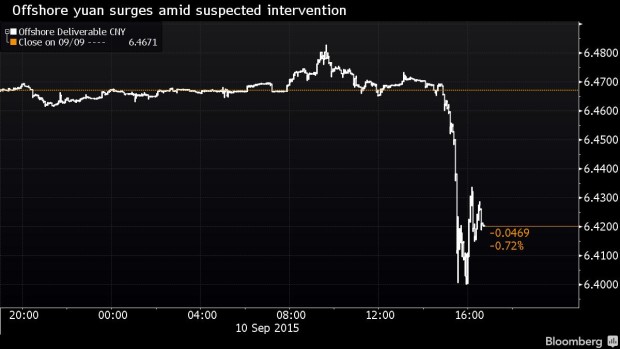China Said to Take Rare Step of Bolstering Yuan’s Offshore Value
China appeared to expand efforts Thursday to bolster its currency in what traders said is an attempt to align its exchange rates at home and abroad.
The yuan rose a record 1.2 percent in the offshore market amid speculation the People’s Bank of China was again acting to contain the months-long turmoil in Chinese financial markets.
The move came on the same day the country opened its domestic foreign-exchange market to overseas central banks.
Traders said the intervention combined with the change in its domestic policy will further China’s long-time goal of making the yuan more of an international currency.
The central bank support of the yuan abroad was the latest in a series of extraordinary efforts to slow the flow of capital out of the country and safeguard the currency following the largest devaluation in more than two decades in August. By aligning the offshore yuan rate with the onshore rate, China is attempting to stem speculation of further declines, traders said.
Intervention Speculation
“There is talk of intervention driving the offshore yuan,” said Khoon Goh, a Singapore-based strategist at Australia & New Zealand Banking Group Ltd. “It would seem that they are trying to damp depreciation expectations and drive a narrowing of the onshore-offshore spread,” he said, noting that it is unusual for the PBOC to intervene outside of the domestic market.
The yuan strengthened to 6.3936 per dollar as of 12:51 p.m. in New York, the biggest one-day advance since offshore trading began five years ago, according to data compiled by Bloomberg. The Deutsche X-trackers Harvest CSI 300 China A-Shares ETF, the biggest exchange-traded fund in the U.S. tracking mainland stocks, rose 2.3 percent to $33.27 on Thursday in New York. The Shanghai Composite Index slid 1.4 percent to 3,197.89 at the close on Thursday.
A phone call to PBOC’s press office after business hours went unanswered.
The government has launched a series of measures in recent months to shore up growth and boost equity valuations, ranging from devaluing the currency to cutting interest rates and cracking down on stock market manipulation to stem a rout that has wiped out $5 trillion in shareholder value.
Since devaluing its currency a month ago and shifting to a more market-oriented exchange rate, China has been intervening to limit depreciation — a policy that led to an unprecedented $94 billion drop in its foreign-currency reserves in August. The yuan will be kept stable at a reasonable level, Premier Li Keqiang said on Thursday at a World Economic Forum meeting in the Chinese city of Dalian, while announcing that foreign central banks would be allowed to trade in China’s domestic currency market.
The PBOC devalued the yuan on Aug. 11, triggering the steepest depreciation in two decades, and said changes to its currency policy would promote a convergence of the onshore and offshore rates. China is pushing for the yuan to be added to the International Monetary Fund’s Special Drawing Rights basket of reserve currencies and an IMF staff report published in the first week of August said a “representative exchange rate” was needed for inclusion.
The central bank cut its reference rate for the yuan by 0.22 percent to 6.3772 a dollar on Thursday, setting it near Wednesday’s close of 6.3778 in Shanghai. The spot rate was about 1.5 percent weaker than the fixing prior to last month’s devaluation. The currency closed little changed in Shanghai at 6.3772 and its discount in the offshore market shrank to 0.4 percent from 1.4 percent.
Convergence Goal
“China wants to converge the three yuan rates: the fixing, the onshore and offshore spot rates,” said Tommy Ong, managing director for treasury and markets at DBS Bank Hong Kong Ltd. “The fight has been quite extreme. There’s been quite a number of short yuan trades and volatility has jumped a lot, especially for the offshore yuan.”
Ong said he “wouldn’t be surprised” if the PBOC intervened offshore, adding that this could be done via banks acting on its behalf. Agency banks were selling dollars in the offshore market as the yuan advanced, according to a currency trader who spoke on condition of anonymity.
Twelve-month non-deliverable forward contracts for the yuan strengthened 0.9 percent to 6.5875 per dollar in Hong Kong, a 3.2 percent discount to the spot rate in Shanghai. The gap swelled to as much as 5 percent following last month’s devaluation. The difference between the yuan’s offshore exchange rate and the onshore was the tightest it’s been since the devaluation.
“There is apparent interest to close the spread between offshore and onshore yuan,” said Patrick Bennett, a strategist at Canadian Imperial Bank of Commerce in Hong Kong. “The closing of the spread will send a signal of less depreciation pressure on the currency overall. We might move into a more stable range, just as Li wishes.”




